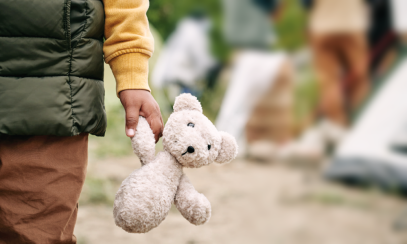
How Can Families Practice the Works of Mercy? - Clothe the Naked
“I was hungry and you gave me food, I was thirsty and you gave me drink, a stranger and you welcomed me, naked and you clothed me, ill and you cared for me, in prison and you visited me.” (Mt 25:35-36)
Jesus’ powerful words in the Gospel of Matthew form the basis for the traditional list of the works of mercy. When it comes to meeting physical needs, the Compendium to the Catechism of the Catholic Church lists the following actions as the corporal works of mercy:
- Feed the hungry
- Give drink to the thirsty
- Clothe the naked
- Shelter the homeless
- Visit the sick
- Visit the imprisoned
- Bury the dead
How can families live this out? Especially with young children, hands-on charitable work can be daunting, but not impossible. The works of mercy will look different for each family. But if you have a desire to introduce your children to acts of charity outside the home, perhaps these ideas can be a gentle nudge to step out as the domestic Church and seek encounters with those in need.
Affirming dignity by clothing the naked
A newborn baby, swaddled moments after birth. A roadside beggar, wrapped in half of St. Martin of Tours’ cloak (faithmag.com/st-martin-tours). A schoolchild, finally replacing a thin fall jacket with a new winter coat. All the works of mercy address a fundamental human need, but “clothing the naked” meets us in one of our most vulnerable states.
Whether literally dressing another person – a small child, or as a caregiver – or providing clothes or linens to someone in need, it’s an act that protects and affirms a person’s dignity. To clothe the naked is to provide shelter and safety. It says, You are worthy of protection, and of others treating you with dignity.
What can this look like for families?
- Set aside an evening to pack large Ziploc bags for the homeless, especially when colder weather begins to arrive. This can be a fun, assembly line-style project for young children, and even doubles as an activity if you need to keep little hands busy during family prayers (try saying a couple decades of the Rosary for the people who will receive the bags). Warm, new socks are often a coveted item.
- If your community runs a personal needs, linen, or clothing closet, children can help organize donations or fold towels.
- Laundry needs are easily overlooked. Have an awareness of who in your circle might be struggling to do laundry – an elderly neighbor with basement stairs, or a family in an apartment relying on shared machines or a laundromat – and consider offering your washing machine and dryer on a certain day of the week. Small shelters often need volunteers to wash linens; your family could pick up a couple loads a month and do it at home. Teach your children to fold the dreaded fitted sheets and pray for the people who’ll be using them that night.
- Does your community serve refugees? Often, people fleeing their home country will be unprepared for the cold weather awaiting them in much of the United States: Get a head start in the fall in collecting winter clothes and accessories.
- Pregnancy resource centers often ask for baby clothes and diapers, especially in larger sizes. Involve your children in hosting a baby shower for an expectant mother in need; this could be a group effort for multiple families to join.
Finally, pray about how God might be inviting your family to clothe the naked in your own lives. Who is struggling in their vulnerability with basic needs such as clothing and hygiene products? Who needs to be cloaked in dignity and reminded they are worthy of love and respect? Ask your children what they think – as parents know, children are often the most observant, and they might provide the answer to that prayer.
Elizabeth Hansen and her husband, Luke, raise their four children in Lansing, where they attend Resurrection Parish.



